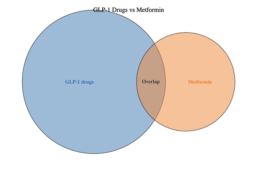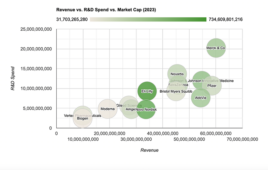 A new real-world study (pre-print) is the first to directly compare weight loss outcomes between the popular diabetes medications Lilly’s Mounjaro (tirzepatide) and Novo Nordisk’s Ozempic (semaglutide). The results show Mounjaro users are significantly more likely to achieve meaningful weight loss.
A new real-world study (pre-print) is the first to directly compare weight loss outcomes between the popular diabetes medications Lilly’s Mounjaro (tirzepatide) and Novo Nordisk’s Ozempic (semaglutide). The results show Mounjaro users are significantly more likely to achieve meaningful weight loss.
Analyzing data from more than 40,000 patients from a large U.S. health database, the researchers found those taking Mounjaro were nearly three times more likely to lose 10% of their body weight compared to Ozempic users. Additionally, they were also almost twice as likely to lose 5% of their weight, and three times more likely to lose 15%.

Tricia Rodriguez
The researchers used 1:1 propensity score matching to balance populations, achieving a balance with all standardized mean differences of <0.05. ” This method achieved excellent balance,” said Tricia Rodriguez, senior applied scientist, Truveta Research, who is first author. The researchers also included key confounders as covariates in their regression analyses to provide additional control for residual confounding. “We also conducted a sensitivity analysis using inverse probability of treatment weighting, to ensure findings were not driven by methodologic choices,” Rodriguez said. “This method also achieved very good balance and produced nearly identical results.”
In terms of study design, the researchers reviewed the clinical trials for semaglutide and tirzepatide and aimed to “emulate them as much as possible. We applied a new user study design and active comparators to reduce bias related to treatment selection,” Rodriguez explained.
Significant weight loss for semaglutide and tirzepatide, but more for the latter
On average, Mounjaro users lost 5.9% of their starting weight after 3 months, versus 3.6% for Ozempic. At 6 months, the gap grew larger, with 10.1% weight loss for Mounjaro and 5.9% for Ozempic. After 1 year, Mounjaro users lost 15.2%, while Ozempic users lost 7.9%.
At the time the study was performed, tirzepatide had not yet won FDA approval for obesity. The drug recently hit that benchmark and will be marketed as Zepbound for obesity. Semaglutide won approval for obesity treatment in 2021 and is being marketed under the name Wegovy for that specific indication. Both drugs initially won FDA approval for managing type 2 diabetes.
In a blog post, Tyler Gluckman, cardiologist at Providence Health, medical director at the Center for Cardiovascular Analytics, Research, and Data Science (CARDS), Providence Heart Institute, and an author on the paper contextualized the data. As tirzepatide only won FDA approval for type 2 diabetes in mid-2022, “the ability to rigorously analyze its use (on- and off-label) for a broad population of patients with overweight or obesity, not just a subset captured in insurance databases, has the power to greatly improve our understanding of how these agents are being used in every day practice and the effect that they’re having,” Gluckman said.
Balancing demographic differences in real-world data
The head-to-head analysis of the two drugs from Truveta Research used multiple methods such as propensity score matching to help balance out initial demographic differences between the two patient groups.
The study population was predominately middle-aged women, though Mounjaro users tended to be younger with fewer health conditions. Weight loss benefits remained consistent even when just looking at patients with type 2 diabetes. Despite these initial differences, the weight loss benefits remained consistent across various subgroups, including those with type 2 diabetes.
Rates of gastrointestinal side effects like nausea were similar between the two drugs. “This real-world data clearly demonstrates the increased weight loss potential with Mounjaro,” said lead author Dr. Nicholas Stucky. “While both medications are effective, Mounjaro appears to be a game-changer for helping patients achieve their weight loss goals.”
“While tirzepatide was significantly more effective than semaglutide, patients on both medications experienced substantial weight loss and we observed no difference in the risk of GI adverse events,” Rodriguez added.
In addition to effectiveness, Rodriguez points to factors like medication availability and insurance coverage as factors likely to influence patients’ choice of medication.
Earlier cost-effectiveness analysis also found edge for tirzepatide
A review in late 2022 noted that tirzepatide resulted in a 17.8% weight loss while semaglutide resulted in a 12.4% weight loss in the SURMOUNT-1 and STEP 1 studies, respectively. At that time, tirzepatide was also more cost effective as the total cost for 72 weeks of tirzepatide treatment was estimated at $17,527 while the cost for 68 weeks of semaglutide treatment was $22,878.
Lilly aims to maintain to undercut semaglutide in terms of pricing with a competitive starting cash price of $1,059.87, positioning it favorably against semaglutide.
Future considerations
A recent summary of the SELECT trial made waves for demonstrating that semaglutide can significantly lower cardiovascular events in patients with obesity but without diabetes. Further data is required to fully understand the potential of GLP-1 drugs in contexts beyond type 2 diabetes management and weight loss support. “Understanding the impacts of these medications on cardiovascular risk is a critical area of future research,” Rodriguez explained. The SELECT trial, which showed reductions in Major Adverse Cardiovascular Events (MACE) for patients on semaglutide compared to placebo, raises questions about how much cardiovascular risk reductions can be attributed to weight loss.
Rodriguez also highlighted the need for studies on “the long-term durability of weight loss, changes in weight and body composition after discontinuation, and long-term safety.” She emphasized the importance of understanding the limited access to these medications and their intersection with social determinants of health (SDOH).
Filed Under: clinical trials, Drug Discovery, Metabolic disease/endicrinology



